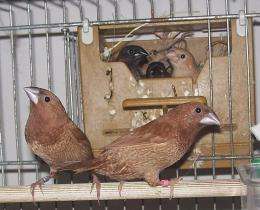June 28, 2011 report
Finches use their own form of grammar in their tweets

(PhysOrg.com) -- In a recent study published in Nature Neuroscience, researchers from the University of Kyoto in Japan have discovered that the tweets of Bengalese finches follow a set of grammatical patterns and rules.
Finches in the wild will react and call back when they hear unfamiliar songs that are usually from intruding finches. Dr. Kentaro Abe and Dai Watanabe used this reaction to test the finches.
They began by playing songs to the finches that were unfamiliar. They played the songs over a period of time until the birds stopped reacting and were used to the new tweets. They then mixed the order of the syllables within the songs and replayed them to the finches. When one of the remixes, named SEQ2, was played almost 90 percent of the birds erupted in response, however the other remixes received no reaction. What the researchers determined was that the finches in a particular social community seem to have some sort of syllable order that must be present within their songs.
In another experiment, the researchers showed that the knowledge of this syllable order is not innate and must be learned. He tested birds that had been raised alone and they showed no response to SEQ2. However, after the isolated birds had spent two weeks with the other birds, they too then showed a reaction.
Another experiment showed that the birds were able to learn ‘new’ grammatical rules if the team played one of the remixes over and over again. Once these birds had learned the new rules, mixing the syllables up again found the birds reacting to a change in the syllable structure.
In a final experiment, Abe and his team chemically shut down an area of the finch brain known as the anterior nidopallium in some of the birds. This area of the brain is vital for the bird’s ability to understand the grammatical pattern in the syllables. He suggests that using this information, and studying the counterpart section of the human brain, could shed new light on the origins of human grammar.
More information: Songbirds possess the spontaneous ability to discriminate syntactic rules, Nature Neuroscience (2011) doi:10.1038/nn.2869
Abstract
Whether the computational systems in language perception involve specific abilities in humans is debated. The vocalizations of songbirds share many features with human speech, but whether songbirds possess a similar computational ability to process auditory information as humans is unknown. We analyzed their spontaneous discrimination of auditory stimuli and found that the Bengalese finch (Lonchura striata var. domestica) can use the syntactical information processing of syllables to discriminate songs). These finches were also able to acquire artificial grammatical rules from synthesized syllable strings and to discriminate novel auditory information according to them. We found that a specific brain region was involved in such discrimination and that this ability was acquired postnatally through the encounter with various conspecific songs. Our results indicate that passerine songbirds spontaneously acquire the ability to process hierarchical structures, an ability that was previously supposed to be specific to humans.
© 2010 PhysOrg.com

















